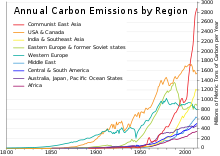Climate change is posing an increasing threat to global socioeconomic development and environmental sustainability.[4] Developing countries with low adaptive capacity and high vulnerability to the phenomenon are disproportionately affected. Climate change in Kenya is increasingly impacting the lives of Kenya's citizens and the environment.[4] Climate change has led to more frequent extreme weather events like droughts which last longer than usual, irregular and unpredictable rainfall, flooding and increasing temperatures.
The effects of these climatic changes have made already existing challenges with water security, food security and economic growth even more difficult. Harvests and agricultural production which account for about 33%[5] of total Gross Domestic Product (GDP)[6] are also at risk. The increased temperatures, rainfall variability in arid and semi-arid areas, and strong winds associated with tropical cyclones have combined to create favourable conditions for the breeding and migration of pests.[7] An increase in temperature of up to 2.5 °C by 2050 is predicted to increase the frequency of extreme events such as floods and droughts.[4]
Hot and dry conditions in Arid and Semi-Arid Lands (ASALs) make droughts or flooding brought on by extreme weather changes even more dangerous. Coastal communities are already experiencing sea level rise and associated challenges such as saltwater intrusion.[4] Lake Victoria, Lake Turkana and other lakes have significantly increased in size between 2010 and 2020[8] flooding lakeside communities.[9] All these factors impact at-risk populations like marginalized communities, women and the youth.[6]

- ^ Hausfather, Zeke; Peters, Glen (29 January 2020). "Emissions – the 'business as usual' story is misleading". Nature. 577 (7792): 618–20. Bibcode:2020Natur.577..618H. doi:10.1038/d41586-020-00177-3. PMID 31996825.
- ^ Schuur, Edward A.G.; Abbott, Benjamin W.; Commane, Roisin; Ernakovich, Jessica; Euskirchen, Eugenie; Hugelius, Gustaf; Grosse, Guido; Jones, Miriam; Koven, Charlie; Leshyk, Victor; Lawrence, David; Loranty, Michael M.; Mauritz, Marguerite; Olefeldt, David; Natali, Susan; Rodenhizer, Heidi; Salmon, Verity; Schädel, Christina; Strauss, Jens; Treat, Claire; Turetsky, Merritt (2022). "Permafrost and Climate Change: Carbon Cycle Feedbacks From the Warming Arctic". Annual Review of Environment and Resources. 47: 343–371. doi:10.1146/annurev-environ-012220-011847.
Medium-range estimates of Arctic carbon emissions could result from moderate climate emission mitigation policies that keep global warming below 3°C (e.g., RCP4.5). This global warming level most closely matches country emissions reduction pledges made for the Paris Climate Agreement...
- ^ Phiddian, Ellen (5 April 2022). "Explainer: IPCC Scenarios". Cosmos. Archived from the original on 20 September 2023. Retrieved 30 September 2023.
"The IPCC doesn't make projections about which of these scenarios is more likely, but other researchers and modellers can. The Australian Academy of Science, for instance, released a report last year stating that our current emissions trajectory had us headed for a 3°C warmer world, roughly in line with the middle scenario. Climate Action Tracker predicts 2.5 to 2.9°C of warming based on current policies and action, with pledges and government agreements taking this to 2.1°C.
- ^ a b c d "Climate Change Profile: Kenya – Kenya". ReliefWeb. Retrieved 24 November 2020.
- ^ "Agricultural Sector Transformation and Growth Strategy" (PDF). Ministry of Agriculture Livestock and Fisheries. 2019. p. 20. Archived from the original (PDF) on 10 December 2020. Retrieved 8 December 2020.
- ^ a b Climate Change in Kenya focus on Children (PDF) (Report). UNICEF.
- ^ Salih, Abubakr A. M.; Baraibar, Marta; Mwangi, Kenneth Kemucie; Artan, Guleid (July 2020). "Climate change and locust outbreak in East Africa". Nature Climate Change. 10 (7): 584–585. Bibcode:2020NatCC..10..584S. doi:10.1038/s41558-020-0835-8. ISSN 1758-678X. S2CID 220290864.
- ^ Tobiko, Keriako (2021). "Rising Water Levels in Kenya's Rift Valley Lakes, Turkwel Gorge Dam and Lake Victoria" (PDF). Kenya Government and UNDP. Archived from the original (PDF) on 9 October 2022. Retrieved 16 March 2022.
- ^ Baraka, Carey (17 March 2022). "A drowning world: Kenya's quiet slide underwater". the Guardian. Retrieved 17 March 2022.

